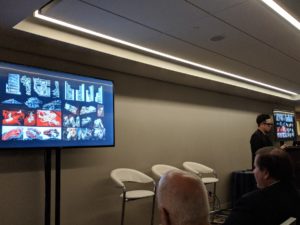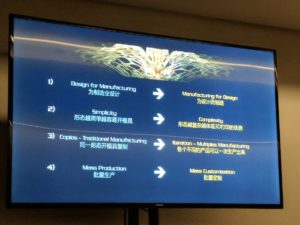Aerospace, Architecture, Consumer Applications Highlight 3D Printing Usage in Additive Manufacturing Symposium
 As additive manufacturing continues its growth trajectory, it is taking its place more firmly in the 3DEXPERIENCE — as highlighted at this week’s Science in the Age of Experience event held in Boston, as Dassault Systèmes opened the happenings with a dedicated Additive Manufacturing Symposium bringing experts together to discuss the progress and challenges of the technology. Following a busy morning plenary session and breakout track presentations, the afternoon of the symposium picked up with dives into aerospace and architecture ahead of a panel discussion focusing on the industry.
As additive manufacturing continues its growth trajectory, it is taking its place more firmly in the 3DEXPERIENCE — as highlighted at this week’s Science in the Age of Experience event held in Boston, as Dassault Systèmes opened the happenings with a dedicated Additive Manufacturing Symposium bringing experts together to discuss the progress and challenges of the technology. Following a busy morning plenary session and breakout track presentations, the afternoon of the symposium picked up with dives into aerospace and architecture ahead of a panel discussion focusing on the industry.
In discussing “Workflow for First-Time-Right Design of Additive Manufactured Parts,” Sjoerd Van der Veen of Airbus looked into the place of 3D printing in aerospace. Airbus has long shown a dedication to embracing and incorporating 3D printing — and Van der Veen highlighted the A350, which already sees “several tens of thousands of certified 3D printed parts flying.” Among these many parts, he noted, are “a lot of polymers, a lot of brackets — and these brackets have to withstand certain requirements.” Titanium is also put to use, and altogether Airbus sees additive manufacturing in aerospace a “proper business case.” Recently, the company introduced a 3D printed component that will be visible to passengers on its A320 aircraft operated by Finnair.
“The value has to be there,” Van der Veen noted. “We’re not doing this just because it’s nice. We’re seeing value-driven applications, where every application has a business case. Parts that require speed, parts that require agile manufacturing, parts that can benefit from optimization and integrate complexity; those are the parts where it really makes sense to bring in additive manufacturing. For the designs, that’s where Dassault Systèmes comes into the picture. There’s a toolset for our designers to move quickly from concept to application.”
Airbus and Dassault Systèmes have been working together across several applications and areas of interest, as tools such as simulation and distortion prediction allow for enhanced design capabilities. Airbus will continue to work toward integrating simulation in topology optimization, he noted, and is always keeping an eye toward the future. Qualification is, of course, a major aspect of consideration for aerospace, and Van der Veen said that Airbus “starts from the easy ones up” as it builds additive manufacturing more fully into its portfolio.
Following the discussion of aerospace, we turned next to Steven Ma of Xuberance for a conversation about architecture — and beyond.
 The Chinese company had so much to showcase that Ma turned up with a 561-slide presentation, focused around the conference themes of Discovering, Personal, Materials, and Sustaining aspects of technology. The whirlwind discussion followed dozens of applications that Xuberance has worked on, as Ma also noted that there is a “very different market in China compared to the US and Europe,” and that he hoped to give more insight into what’s happening in China.
The Chinese company had so much to showcase that Ma turned up with a 561-slide presentation, focused around the conference themes of Discovering, Personal, Materials, and Sustaining aspects of technology. The whirlwind discussion followed dozens of applications that Xuberance has worked on, as Ma also noted that there is a “very different market in China compared to the US and Europe,” and that he hoped to give more insight into what’s happening in China.
“I started the company in 2008, and have been doing long-term research since 2014 in 3D printing. In 2014, I started to do a lot of prototyping and materialization,” Ma said. “We’re really interested in the consumer market right now; in China, this is the biggest market, not aerospace, not medical. We are a 3D printing design company based in Shanghai… B2B is the main focus of our business model.”
Xuberance has progressed significantly since that 2014 turn to additive, refining its offerings and business model through the years. Between 2016 and 2017, the company used a record of 54 tons of full-color 3D printing powder for use on 3D Systems multi-color technologies; in 2017, Xuberance opened the first China 3D Printing Cultural Museum in Shanghai with 5,000 square meters of space dedicated to additive manufacturing in the country. The company has also opened a 3D Print Café, with Ma noting that most product sales take place offline through the cafes than online (and with coffee outselling 3D printed products). Xuberance also offers a 3D Design Center with 3D printing and robotics, including ceramics capabilities, large-scale FDM for futniture, and conceptual work in concrete 3D printing.
In addition to architecture — including a project with the esteemed Zaha Hadid Architects firm — Xuberance has worked in high fashion, incluing a haute couture fashion show in Minneapolis on 2015 using EOS SLS 3D printing, as well as a current project with designer Maurizio Galante to create a series of 3D printed fashions using TPU material. In 2014, Xuberance worked on wedding-themed 3D printing — for Ma’s own wedding. The company has also created a 3D printed violin, skateboard, trophies, jewelry, lighting, fountain pens, and projects for museums, the Beijing Palace, and Adventureland among the myriad endeavors briefly highlighted.
“We need to sustain, we need to make real products for the consumer market,” Ma said. “It’s the beginning of the era of 3D printing in China.”
Following these looks into applications for 3D printing in today’s global business environment, a panel discussion brought together experts for a lively conversation. Stay tuned for insights into barriers to entry, the evolution of industrial 3D printing, impacts on the supply chain, and more.
Discuss Dassault Systèmes, industry challenges, and other 3D printing topics at 3DPrintBoard.com or share your thoughts in the Facebook comments below.
[All photos: Sarah Goehrke]
Subscribe to Our Email Newsletter
Stay up-to-date on all the latest news from the 3D printing industry and receive information and offers from third party vendors.
You May Also Like
3D Printing Unpeeled: New Arkema Material for HP, Saddle and Macro MEMS
A new Arkema material for MJF is said to reduce costs per part by up to 25% and have an 85% reusability ratio. HP 3D HR PA 12 S has been...
3D Printing News Briefs, January 20, 2024: FDM, LPBF, Underwater 3D Printer, Racing, & More
We’re starting off with a process certification in today’s 3D Printing News Briefs, and then moving on to research about solute trapping, laser powder bed fusion, and then moving on...
3D Printing Webinar and Event Roundup: December 3, 2023
We’ve got plenty of events and webinars coming up for you this week! Quickparts is having a Manufacturing Roadshow, America Makes is holding a Member Town Hall, Stratafest makes two...
Formnext 2023 Day Three: Slam Dunk
I’m high—high on trade show. I’ve met numerous new faces and reconnected with old friends, creating an absolutely wonderful atmosphere. The excitement is palpable over several emerging developments. The high...





































